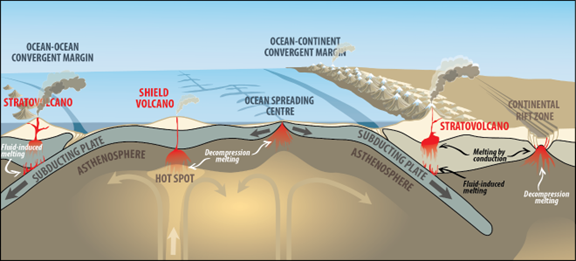THE APPROACH
THE INTRODUCTION: Briefly describe how the movement of plate tectonics shape the landforms of first order.
THE BODY
-
- State the mechanism with relevant examples.
THE CONCLUSION: Role played by tectonic plates in reshaping earth.
THE INTRODUCTION:
The changes in the shape and sizes of continents and ocean basins are primarily driven by the dynamic processes of tectonic plate movements in Earth’s crust.
THE BODY:
Mechanisms of change:
-
- Seafloor spreading & ocean expansion: At mid-oceanic ridges, tectonic plates pull apart, allowing magma to rise and create new oceanic crust. This process expands ocean basins, such as the Atlantic Ocean, which continues to widen as plates diverge.
Example: Atlantic Ocean continues to widen due to seafloor spreading at the Mid-Atlantic Ridge.
-
- Subduction & ocean shrinking: At convergent boundaries, oceanic plates are subducted beneath continental or other oceanic plates, forming deep ocean trenches. The Pacific Ocean is shrinking as its crust is steadily consumed through subduction zones along its margins.
Example: Pacific Ocean is shrinking as crust subducts at the “ring of fire” boundaries, leading to deep trenches and island arcs.
-
- Mountain building: Where plates converge, compressional forces create mountain ranges (e.g.- Himalayas, Andes.), affecting the shape and elevation of continents.
Example: Himalayan are created by the collision of the Indian and Eurasian plates, expanding Asia’s landmass and altering its shape.
-
- Formation and closure of ocean basins: Rift valleys may evolve into new ocean basins, while ongoing collisions and subduction can close or alter existing basins, as seen in the historic closure of the Tethys Sea.
Example: East African Rift represents a continent splitting, which may eventually form a new ocean basin.
-
- Volcanic and earthquake activity: These events, closely related to plate boundaries, further modify landforms, create islands, or submerge land, affecting both continents and oceanic shape.
Example: Andes Mountains along the coast of South America, Indonesian archipelago.

THE CONCLUSION:
Tectonic movements like divergence, convergence, and transform faulting, constantly reshape Earth’s continents and ocean basins, redistributing land and sea over geological time and profoundly influencing climate, biodiversity, and planetary evolution.
Spread the Word
